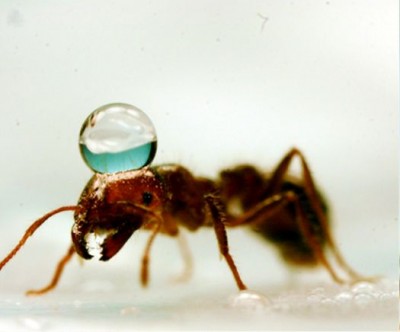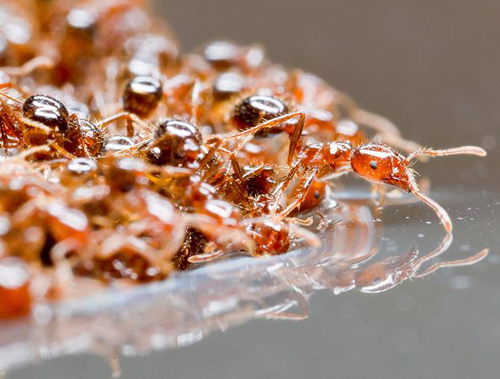| |
Ant raft
It's the ultimate vehicle for an emergency flood escape. It can assemble itself in about 100 seconds, and keep thousands to millions of passengers safe and afloat for days, even weeks.
Floating clusters of fire ants are a feat of natural engineering, and some researchers wanted to know just how these ants create such safe, long-lasting rafts out of themselves. The result means they can survive floods in their native South American habitats as well as migrate long distances.
In the first serious study of the physics of fire-ant rafts, researchers have described how the insects form floating, waterproof islands.
In nature, the rafts allow fire ants to survive epic rainstorms in their native Brazil. In the lab, they could help inspire designs for small, swarming robots that might someday be used to explore inaccessible areas or even clean up oil spills.
"The ant raft, up to this point, has been little more than just categorised and documented," said mechanical engineer Nathan Mlot of the Georgia Institute of Technology, lead author of a paper in the 25 April Proceedings of the National Academy of Sciences. "We were coming at it from an engineering perspective."
Even though ants' exoskeletons naturally repel water, a lone ant dropped in a bucket will flounder. But whole colonies of fire ants can float downstream for weeks at a time when flushed from their underground nests. Mlot and his graduate advisor, David Hu, wondered what held the dense mass afloat -- and whether it could be harnessed for other applications.
Mlot's team collected thousands of fire ants (Solenopsis invicta) by roadsides in Atlanta, where the stinging pests are an invasive species. They immediately noticed that clumps of ants take on the consistency of soft playdough. Ant masses flow like honey or ketchup, and can be described using equations usually found in fluid dynamics.
"You could pick up a cluster of these ants and mould it in your hand. You could form it into a ball and toss it up in the air, and all the ants would stay together in one ball," Mlot said. "They're almost like a material."
To set up a reproducible experiment, the team moulded ants into balls by swirling them in a beaker. The ants' natural tendency to stick together made them clump into near-perfect spheres.
Then the researchers placed balls of 500 to 8,000 ants into a water-filled filled container. The ant sphere almost immediately relaxed into a flat, pancake-shaped raft, with ants on bottom forming a stable layer for the rest of the colony to rest on.
Surprisingly, the whole swarming mass remained delicately balanced atop the water's surface. When the researchers tried to submerge the raft, water underneath deformed like a stretchy fabric, conforming to the raft's underside contours.
(sourced from http://www.wired.co.uk/news/archive/2011-04/26/ant-rafts and http://www.livescience.com/13867-raft-fire-ants-buoyancy-flood-water-repellant-floatation.html)
Links:
ant raft video at wired.com
nathan mlot
|
|
|


